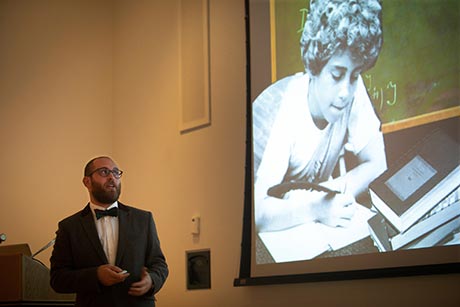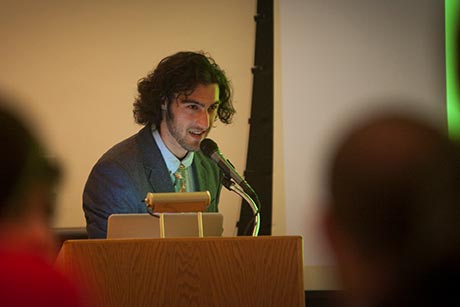Students present wide range of humanities research
By Sascha Hernández


At first glance, the linguistics of lying, the architecture of Rio de Janeiro and violence against Alaska Native women may seem entirely unrelated. However, they were some of the topics Cornell humanities undergraduate researchers presented April 23 at the Herbert F. Johnson Museum of Art.
The Third Annual Humanities Showcase included three research exhibitions and 14 oral presentations by students. College Scholar Rudy Gerson ’15 discussed visualizing community work in his talk, “The Geography of Creative Activism: Representing a Community-Based Theater.” Gerson helped create a community-based play about police relations with the Civic Ensemble, a local theater company.
“This is art made by the people for the people and by people who may not consider themselves artists,” Gerson said. He created maps of the project, which emphasized development of the play over time and its focus on all parts of the city of Ithaca. “If you can’t break the discursive boundaries of neighborhoods ... then you’re not making connections,” he said.
Justin Khalil ’16, a chemical engineering student, also discussed breaking boundaries. He started his presentation by performing a rap song about evaporative cooling from his educational YouTube show, “Hip Science.” The show combines scientific demonstrations and music to “empower people to want to learn,” he said. Hip-hop, he explained, can help students overcome reservations about science and connect to the material on their own terms. “Everyone learns differently and thinks differently,” Khalil said.
Victoria Nadile ’15, a science and technology studies major, addressed Hawaiian agricultural practices in her talk,“Mālama ‘Āina,” which means “to take care of the land,” she said. Before the arrival of Europeans, Hawaiians took care of the land by subsistence farming and using methods introduced by the Polynesians who settled the islands. After the arrival, Hawaiian agriculture became export-oriented and dominated by plantations. To this day, Hawaii has to import the majority of its food, she explained, but in recent years, there have been experiments to return to sustainable, traditional agricultural practices, particularly on the island Moloka’i. Nadile suggested that agro-ecology, in which natural predators are used instead of pesticides and monocultures are avoided, also could help the island gain food sovereignty.
Other students discussed the African queer community, how to redevelop a slum in Manila, diglossia (speaking two languages) in the Jordanian Parliament, and how to direct for the theater, among other things.
The showcase was presented by the Cornell Undergraduate Research Board.
Sascha Hernández ’17 is a writer intern for the Cornell Chronicle.
Media Contact
Get Cornell news delivered right to your inbox.
Subscribe